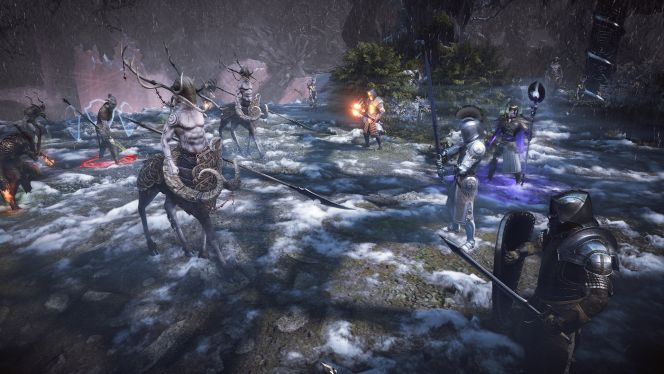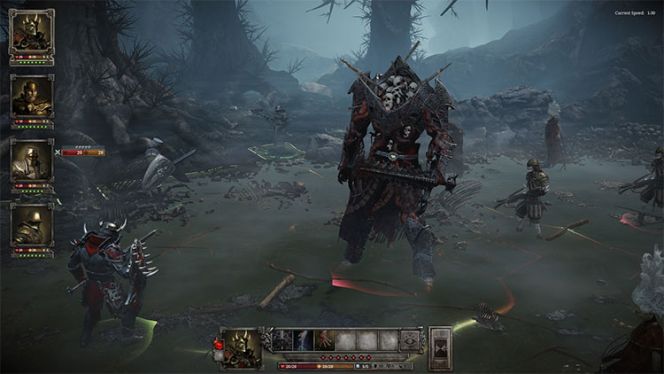REVIEW – The release of King Arthur: Knight’s Tale in 2021 was heralded as the Holy Grail of hardcore tactical RPG enthusiasts, yet console gamers were left out of the adventures of the Knights of the Round Table. NeocoreGames, seasoned in adapting Arthurian legends, has now brought the strategic campaign of Arthur’s bastard son, the resurrected Mordred, set in the dark ages, to the latest generation consoles. We tested the game on PlayStation 5, courtesy of NeocoreGames.
King Arthur: Knight’s Tale narrates the twisting path of Mordred, who returns from the afterlife to face his mission: to slay the darkened King Arthur, thereby saving the land of Avalon from fatal ruin. The story dives straight into the action with a quick introduction, aiming to immediately direct our perspective towards the protagonists and the conflicts surrounding them.
Throughout the main storyline, Mordred seeks allies across Avalon to confront the king, and this narrative direction remains surprisingly straightforward over the game’s lengthy duration. Some may have expected a more convoluted, twisty story, but I find that this direct approach allows for a deeper acquaintance with the characters, despite none being particularly complex.
Not every character resonated with me; some were quickly sidelined, while others became loyal companions out of habit or affection by the end. While player choices influence the game’s flow and the characters that can be enlisted, these decisions rarely bring pivotal changes to the main story, keeping Mordred’s primary mission in focus without significant alteration.
It’s worth noting that the game’s atmosphere is quite grim and horror-esque, which I enjoyed, but might not appeal to everyone. This Arthurian world, darker than even the ’81 film Excalibur, lacks the humor found in that mostly epic portrayal of the dark ages, offering serious and dramatic conflicts with little else. It’s certainly no A Connecticut Yankee in King Arthur’s Court!
If it’s battle you want, battle you shall have!
In the world of King Arthur: Knight’s Tale, you’ll spend most of your time in combat, unfolding in a familiar top-down, grid-based battle system where you pit your strength against the enemy in various corners of the arenas. You usually engage in these battles with a carefully selected four-member team, aiming to defeat and tactically outmaneuver the opponent, while exploring the location on foot with your noble knights between fights.
This battle system is quite similar to other representatives of the genre but works exceptionally well here, offering the chance to devise meticulous strategies generously rewarded by the game. A rich selection of unit types encourages experimentation with new team members who join the fray early in the game.
These characters faithfully follow genre archetypes: archers and wizards prefer long-distance engagements, while armored warriors endure the brunt of close combat. Weapon accuracy isn’t a concern; if you position your team wisely, every strike hits its mark. While damage can vary, adding excitement to battles, archers are notably precise in this world.
I quickly adapted to the control system, but a “cancel” button would have been useful for moments when a wrong move wasted a step, or the cursor wasn’t where it was supposed to be. This, partly due to my lack of adaptability, but given the game encourages experimentation, this oversight was quite frustrating.
The “Skirmish” mode selected from the main menu offers additional opportunities for clashes outside the main story, adding a pleasant variety to the campaign. However, these battles tend to unfold in a similar manner, which can become monotonous over time, exacerbated by increasingly familiar locations.
Arming for the challenges ahead
In King Arthur: Knight’s Tale, Camelot Castle is the center of your realm, where everything is under your control: building your army, developing your fortress, strategizing. Here, you have the chance to act as a true king: your decisions carry serious consequences, and Camelot is not only a home for your warriors but also the heart of your story. The goal? To reclaim the glory of the past.
Managing Camelot involves more than just building and commanding; you’ll also handle facilities and resources. Your reserve soldiers are housed here, kept in peak condition with various training options. There’s also the opportunity to upgrade their equipment, ensuring they’re always battle-ready. The care of the wounded in the hospice requires special attention: managing injuries and recovery times is vital, as every warrior counts. You must be frugal with their health, as battles are won not just with strength but with smart strategy.
Treating injured warriors presents a real challenge: you must leave them in the hospice to rest for a few battles until they can return to form. You can choose to send them into battle with injuries, but remember, death here is permanent on all difficulty levels, with few exceptions. This dynamic, where combat and strategic management intertwine, creates an engaging cycle that becomes increasingly thrilling as the game’s difficulty rises, making my decisions all the more consequential.
The complexity of the Camelot management system, where the Round Table plays a crucial role, further deepened my gaming experience. I spent hours experimenting with different strategies between missions and challenges, which made the game truly enjoyable.
Not for novices
King Arthur: Knight’s Tale is not a game I’d recommend for beginners. While it’s not the hardest game you’ll ever encounter, it confronts you with a plethora of mechanics and user interfaces that are not the easiest to grasp. This becomes especially apparent when preparing your team for battle.
Creating a successful team requires a good knowledge of the genre, so if you’re drawn solely by the game’s style and medieval theme, this might not be the best choice for you. Although the game’s deep mechanical systems are impressive, the tutorials provided for new players do not offer enough assistance for a deeper understanding of the game.
I should also mention that, contrary to expectations, the PS5 version of King Arthur: Knight’s Tale seems not to fully leverage the console’s unique capabilities, such as the innovative features of the DualSense. Some sound effects, music, and dialogues are played through the DualSense speaker, offering a kind of interactive experience, but it doesn’t reach the level seen in other titles.
King Arthur: Knight’s Tale definitively delivers what it sets out to do: offer a complex and thoroughly crafted strategic experience in the world of medieval legends. However, it appears that the game does not quite surpass the level that veteran strategy game fans may have grown accustomed to over the years. The foundations are excellently laid, and there’s plenty of room for experimentation, but the game’s grim atmosphere can become burdensome over longer play periods, especially with somewhat grey, dull graphics – which, while perhaps not as noticeable on a PC monitor, become quite apparent on a large 4K TV.
Thus, King Arthur: Knight’s Tale is recommended for those who are comfortable navigating the world of strategy games and are looking for a new challenge that requires deeper tactical thinking. Beginners, however, might find it harder to find their footing in this complex and relatively difficult game, and might do well to look towards more accessible titles.
The game, therefore, presents a dichotomy: while it impresses experienced players with its depth and complexity, it may easily deter novices. In light of this, King Arthur: Knight’s Tale targets a specific audience ready to dive deep into the dark, grim medieval world of King Arthur as well as the intricacies of its interface and game mechanics.
-Gergely Herpai (BadSector)-
Pros:
+ Deep, layered strategic elements and management system
+ Faithful transfer from PC to PS5, enjoyable combat system
+ Complex and interesting Camelot “management”
Cons:
– Not beginner friendly, mechanics and user interfaces can be complicated
– Low utilization of PS5’s unique capabilities
– The gloomy atmosphere and gray visual world of the game may scare some
Publisher: NeocoreGames
Developer: NeocoreGames
Style: Tactical RPG
Release: 2021 (PC), 2024 (PS5, Xbox Series X/S)
King Arthur: Knight’s Tale (PS5)
Gameplay - 8.2
Graphics - 6.8
Story - 6.5
Music/Audio - 8.2
Ambience - 8.4
7.6
GOOD
King Arthur: Knight's Tale is a complex strategy RPG that takes the classic Camelot legend and gives it a modern twist, adding strategic management challenges to the gameplay. Although the game is not aimed at beginners, and makes limited use of the PS5's advanced features, it offers experienced strategy players a rich and rewarding challenge in managing Camelot and its facilities. In the long run, however, the game may not appeal to everyone due to its gloomy mood, drab graphics, repetitive gameplay and simple storyline.


















Leave a Reply